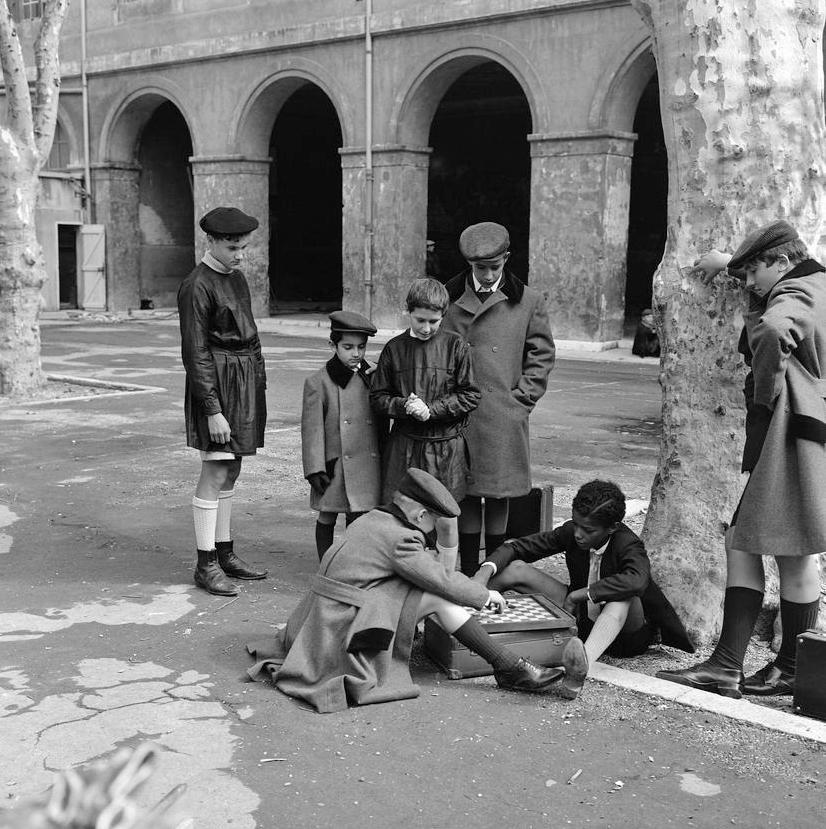
French School Uniform: Activities--Coming and Going to School

Figure 1.--Here we see some French boys right after school. The photograph is undated, but we would guess the mid-1930s. We also do not know the location. Perhaps our French readers will recognize the building. We think the boys pictured are from two different schools and are enjoying a game of chess after school. The boys wearng berets and smocks presumably a state school. The boys in identical flatcaps and overcoats probably attend a toney private school. Notice that they also have attache casees for their books. We are unsure why the boys in smocks do not have their school books with them. We are not sure about the Algerian boy. He is not wearing a smock.
|
|
We do not yet have a lot of information on French children coming and going to school. We note a range of images of French boys going to school in the morning and coming home in the afternoon which help to provide siome insights. In the morning the boys are mostly hurrying to get to school on time. Thus they are not stopping to play or engage in other activities. This is different in the afternoon. Some parents may insist on the children coming straight home rightaway. But most parents were probably more flexible on this, alowing the children to play a little if they wanted to do so. This could be a range of play activities, includng sports, horseing around, games and much else. Some may have stopped at a sweets shop if they had a penny or two. Some boys may have wanted to go right home to take their smocks off. Others were pobably not all that concerned about the smocks. Most primary children probably walked to school as the schools were small and probably near home. This was the case before and immeditely after World War II. With rising affluence and more car ownership, this is probably somewhat less true today. Security is also greater concern today. We are less sure about secondary students. Some would have had to use public tranportation.
Chrnology
Going to School
We do not yet have a lot of information on French children coming and going to school. We note a range of images of French boys going to school in the morning and coming home in the afternoon which help to provide siome insights. In the morning the boys are mostly hurrying to get to school on time. Thus they are not stopping to play or engage in other activities.
Coming Home
This is different in the afternoon. Some parents may insist on the children coming straight home rightaway. But most parents were probably more flexible on this, alowing the children to play a little if they wanted to do so. This could be a range of play activities, includng sports, horseing around, games and much else. Some may have stopped at a sweets shop if they had a penny or two. Some boys may have wanted to go right home to take their smocks off. Others were pobably not all that concerned about the smocks.
Transport
Most primary children probably walked to school as the schools were small and probably near home. This was the case before and immeditely after World War II. With rising affluence and more car ownership, this is probably somewhat less true today. We are less sure about secondary students. Some would have had to use public tranportation.
Security is another matter connected with going to school. Most of the images we see are the children going to school on their own, even quite young children. Parents would have probably taken children to school on their first day. But as soon as the little ones felt comfortable they were allowed to go to school on their own. They may hve been acconpanied by older siblings or neigborhoo friends. We notice some parents taking the children to school in the photograohic record, but as far as we can tell, it was not very common. France has traditionally been a very safe country and still is, but developments in recent years must be causing some concern among French parents. Terror attacks have included attacks on childten, such as the 2012 murder of the precious little school girl, Myriam Mosenegro. There are now some high crime areas in French cities, porimarily mus;im neighborhoods. This includes areas where the police avoid. We are not sure about schools in these neighborhoods.
HBC-SU

Related Chronolgy Pages in the Boys' Historical Web Site
[Main Chronology Page]
[The 1880s]
[The 1930s]
[The 1940s]
[The 1950s]
[The 1960s]
[The 1970s]
[The 1980s]
Related HBC Style Pages:
[Main country page]
[Long pants suits]
[Short pants suits]
[Smocks]
[Socks]
[Eton suits]
[Jacket and trousers]
[Blazer
[Rompers
[School sandals]
<
Navigate the HBC School Country Pages
[Return to the Main French school activities page]
[Return to the Maun French school page]
[Return to the Main School Uniform Page]
[Australia]
[England]
[Germany]
[Italy]
[Japan]
[New Zealand]
[Scotland]
[United States]
Navigate the HBC School Section:
[About Us]
[Activities]
[Chronology]
[Clothing styles]
[Countries]
[Debate]
[Economics]
[Garment]
[Gender]
[Hair]
[History]
[Home trends]
[Literary characters]
[School types]
[Significance]
[Transport and travel
[Uniform regulations]
[Year level]
[Other topics]
[Images]
[Links]
[Registration]
[Tools]
[Return to the Historic Boys' School Home]
Created: 9:03 PM 4/18/2013
Last updated: 1:32 PM 12/13/2017




